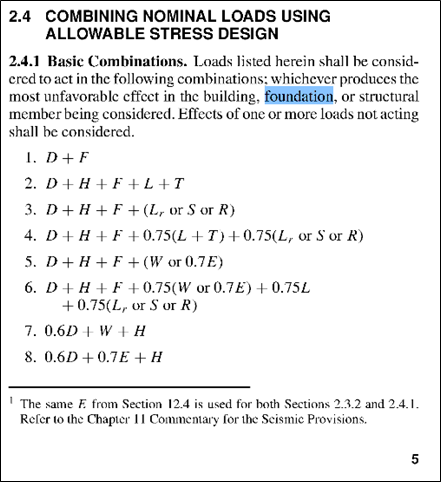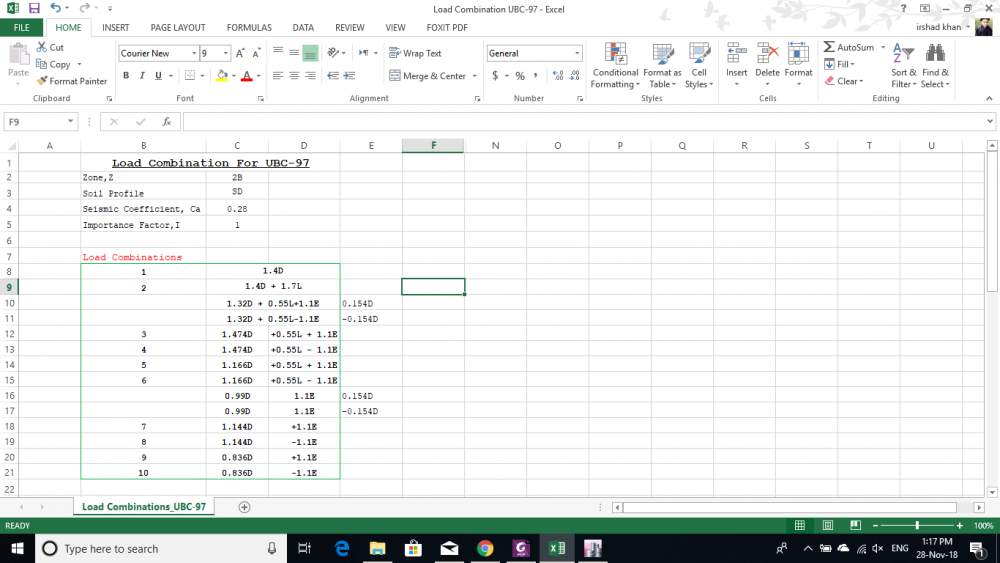Search the Community
Showing results for tags 'Load combinations'.
-
Hi Everyone, I have defined various load combinations such as 1.4D, 1.54D-1.1E, 0.77D-1.1E, 1.54D+0.55L+1.1E etc. for the analysis & design of RC structure. However, when I display design information for beam and column longitudinal and shear reinforcement, the program etabs and SAP do the design and display the reinforcement but they do not show the load combination on which the design is displayed. How the program does the design? Does the program automatically design beam and column based on taking maximum values from the defined different combination or take envelope? Shell area elements are clear as we can view the results for our various defined combos. Thank you
-
Dear Respected Engineers, ASCE7-05 states: 1. So, for the purpose of finding soil bearing pressure and comparing it with allowable soil bearing capacity (shortly for foundation sizing), are we supposed to use the above-listed combinations? 2. If the above combinations are to use for foundation sizing, then do we apply the SBC overstress of 33% when lateral loads are used with gravity loads? 3. If the above combinations are used for foundation sizing, we have to include the vertical EQ effect with the horizontal EQ effect? That's what ASCE-7 05 says, but I want to know if there is anything else. 4. What about the following combinations? I had always thought these are the only combinations to use for sizing foundations, be it shallow or deep. 5. If the above-mentioned green load combinations are permitted to use for proportioning foundation size or finding pile numbers, do we need to include the vertical EQ effect? Thanks all. Your valuable response is highly appreciated.
-
I am so happy to finally find this phenomenal platform to ask questions from professionals! So I used to work in a private company in Lahore where we would use auto-generated load patterns in ETABS v9. After my MSc from UK I just had an interview at another firm last week where I was embarrassed to know that we should manually generate load combinations instead of using system generated combos for frame design! Now this got more confusing when I saw some YouTube videos where they defined load patterns manually using UBC97 (which is an easy case since it have just 5 load cases I think) but since ETABS v18 doesn't come with UBC-97and ACI load cases have like 19 load cases, (1) should I put all 19 cases manually? (2) What is really wrong with auto-generated frame combinations? why some people on YouTube and interviewer said we have to put them manually? (3) Suppose I need to design a foundation and for that I display Base Reactions after analyzing the structure, against which load combination I should be seeing the values of base reactions? Will it be the one with the maximum value of Pz, calculated from Load combination provided/ generated before? (4) Can we mix multiple design codes in 1 model? I mean what if I use UBC-97 (say in an older version), can I use ACI as a design preference and for Load combination as well? because it confuses me that older versions of ETABS doesn't come with UBC-97 as a design preference code but surprisingly it still have UBC-97 in defining load patterns where we put Dead, Live, Earthquake and Wind load data etc. Since the system allows us to pick different codes at different staged, does this mean there will be no serious effect on results? Many thanks for reading this. Please let me know if there is a need of screenshots to answer.
-
I am making manual load combination and I got struck in calculating Mapped spectral response acceleration Ss in order to calculate vertical component of earthquake Ev=0.2SdsD we have to calculate Sds which is equal to Sds=2/3Sms . and Sms=FaSs now according to section 11.4.1 of ASCE 7-05 it says in order to calculate Ss see figure 22-1 through 22-14 but these figures are maps and they are for US so how to calculte this parameter or whats the alternative for this problem to calculate vertical component of earthquake i am also attaching a picture of load comtination from ASCE 7-05
- 38 replies
-
- load combinations
- S1 value
- (and 2 more)
-
Dear All Please explain how ETABS V 9 create Load Combinations, the load combinations for Seismic Zone 2B and Soil Profile SD is not matching with the load combinations made by ETABS v9 I am attaching the Load combination of UBC-97 calculated manually...
-
Foundation load combinations . i am analyzing concrete frame structure, i have assigned load combination of service (dead, super imposed dead ,live load with Earthquake + and - direction). after analysis run i found that due to one of the combination with Earthquake load there is support reaction in downward direction which shows that there is tensile force produced at that column or location. also the compression or upward support reaction value is much greater ( cross limits of Bearing capacity). But when i do only service load analysis without Earthquake load so everything is ok. . so Please guide me which load combination i have to take for it . Kindly if possible give proper reference of any standard document. your early response will be highly appreciated. Thanks
-
Which load combinations of asce/sei 7-10 can be used in pakistan? Which cann't be used ? And what will be the alternative method to impose it?
-
Assalam o alaikum, Dear seniors, I am to design a two story frame structure in Seismic zone 3. UBC tells me about two SPECIAL SEISMIC LOAD COMBINATIONS. For Zone 1, 2 A, 2B I use ASD load combinations for footing stability design i.e. bearing pressure check, uplift check, sliding check and over turning check. But for zone 3 should i include this special seismic load combinations for footing design also?? Section 1612.4 tells, for both ASD and LRFD the following special load combos should be used 1.2D + f1L + 1.0Em and 0.9D + 1.0 Em...................... for both ASD nd LRFD same combination?? I am very much confused and need urgent reply... Jazak Allah...
- 1 reply
-
- load combinations
- foundation design
-
(and 1 more)
Tagged with:
-
Assalam o alaikum, Dear seniors, I am to design a two story frame structure in Seismic zone 3. UBC tells me about two SPECIAL SEISMIC LOAD COMBINATIONS. For Zone 1, 2 A, 2B I use ASD load combinations for footing stability design i.e. bearing pressure check, uplift check, sliding check and over turning check. But for zone 3 should i include this special seismic load combinations for footing design also?? Section 1612.4 tells, for both ASD and LRFD the following special load combos should be used 1.2D + f1L + 1.0Em and 0.9D + 1.0 Em...................... for both ASD nd LRFD same combination?? I am very much confused and need urgent reply... Jazak Allah...
- 2 replies
-
- load combinations
- service load combinations
- (and 2 more)
-
why dead load is decreased by multiplying by 0.9 in some of load combinations in ACI???









.thumb.jpg.700916fbc7ead330085e15745d0270bd.jpg)
